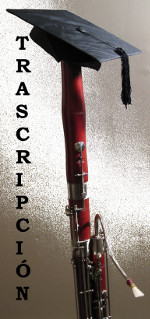TUTORIAL
1. Welcome, this is Terry Ewell. Weissenborn gave the key of C# major for this study in his original collection of 60 studies. Perhaps the key signature was changed because there is no other study in Db major in the present collection of 50.1. Bienvenidos, yo soy Terry Ewell. Weissenborn le dio a este estudio la tonalidad de Do# mayor en la colección original de 60 estudios. Tal vez cambió la armadura porque no hay otro estudio en Reb mayor en la colección de 50.
2. There are three aspects of study #40 I want you to notice. We have dealt with all of these aspects in prior studies, so this will reinforce what you have already learned.
2. Hay tres aspectos del estudio Nº40 que quiero que observe. Hemos lidiado con todos estos aspectos en estudios anteriores, así que esto va a reforzar lo que ya ha aprendido.
3. The transitions from divisions of three to four in the first line are made all the more difficult with the eighth note on the down beat. I suggest you practice this with a metronome in these ways. First tongue on a monotone the divisions of threes and fours.
3. Las transiciones desde divisiones en tres a divisiones en cuatro en el primer pentagrama, se hacen más difíciles debido a la corchea en el primer tiempo. Le sugiero que practique esto con un metrónomo de estas formas. Primero articule sobre una misma nota las divisiones en tres y en cuatro.
4. Then tongue the rhythm as printed on a single tone. Now practice the passage as printed.
4. Luego toque el ritmo como está escrito, sobre una sola nota. Ahora practique el pasaje como está escrito.

5. Las notas ligadas a menudo suenan más fuerte que las notas articuladas. Si algo, debe darle más aire a las notas articuladas.
6. Don’t play like this:
6. No toque así:
7. Instead keep the dynamic even.
7. En lugar de eso, mantenga un matiz constante.
8. In line 6, measure 2 the notes are difficult to perform. Put to use rhythms and sprints here. If you need to review these principles, please look at the earlier videos in this series.
8. En el segundo compás del sexto pentagrama, las notas son difíciles de tocar. Ponga en práctica la variedad de ritmos y carreras para estudiar este pasaje. Si necesita rever estos principios, por favor vea los videos previos de esta serie.
9. The breath indicated in the study by Weissenborn is rare! He gives only two breath marks in all of the studies and this is the first one. It indicates not only a place to breathe but also the start of new musical material.
9. La respiración indicada por Weissenborn en el estudio es extraña! Él da sólo dos indicaciones para respirar en todos los estudios, y ésta es la primera. Ella indica no sólo un lugar para respirar, sino también el comienzo de un material musical nuevo.
REFLECTION Reflexión
10…there are a whole set of inner problems that we also face and which directly affect our outer performance…As we turn to examine the inner world, with its teeming doubts and hopes and expectations, we need to know just what is going on inside us.10. ...hay todo un conjunto de problemas internos al que nos enfrentamos, que afectan directamente nuestro desempeño externo... Al examinar el mundo interior, con sus dudas, esperanzas y expectativas, necesitamos saber qué es lo que está ocurriendo adentro nuestro.
Barry Green, The Inner Game of Music (New York: Doubleday, 1986), pp. 11-12.

11. Como músico, usted probablemente se está dando cuenta de que la música es más que solamente el sonido físico; es algo interno. La música mueve emociones y revuelve nuestra vida interior. Es de esta vida interior que los músicos extraen su música.
12. Barry Green with co-author W. Timothy Gallwey both recognize that there is an important connection between the “inner game” and the “outer game.” Timothy Gallwey in his well-known book The Inner Game of Tennis presents this relationship with practical approaches to tennis playing skills.
12. Barry green, con el co-autor W. Timothy Gallwey ambos reconocen que hay una conexión importante entre el “juego interno” y el “juego externo”. Timothy Gallwey presenta esta relación con acercamientos prácticos a las habilidades en el juego del tenis.
13. Turmoil in your inner life will bring forth turmoil in your outer life. Peace in your inner life will bring forth peace in your outer life. Your inner life determines the course for many aspects of your existence.
13. Una turbulencia en su vida interna puede resultar en turbulencia en su vida externa. La paz en su vida interna resultará en paz en su vida externa. Su vida interior determina el curso de muchos aspectos de su existencia.
